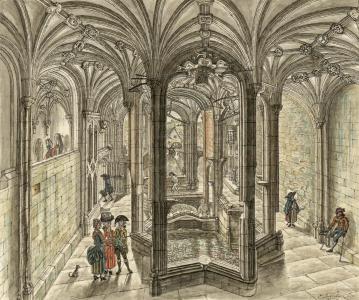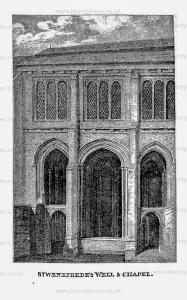A Tour of Wales by Thomas Pennant
A Tour of Wales by Thomas Pennant is in Victorian Books.
The road from hence is remarkably picturesque, along a little valley, bounded on one side by hanging woods, beneath which the stream hurries towards the sea, unless where interrupted by the frequent manufactories. Its origin is discovered at the foot of a steep hill, beneath the town of Holywell or Treffynnony to which it gave the name. The spring boils with vast impetuosity out of a rock ; and is received into a beautiful polygonal well, covered with a rich arch supported by pillars. The roof is most exquisitely carved in stone. Immediately over the fountain is the legend of St. Wenefrede on a pendent projection, with the arms of England at the bottom. Numbers of fine ribs secure the arch, whose intersections are coupled with sculpture.
Some are mere works of fancy ; grotesque figures of animals: but the rest allude chiefly to the Stanley family. This building, and the chapel over it, rose from the piety of that great house, which left these memorials of its benefactions: there are besides some marks of the illustrious donors ; for example, the profile of Margaret, mother to Henry VII., and that of her husband the earl of Derby cut on the same stone.


The compliments to the Stanlies, are very frequent. The wolf's head is the arms of the earls of Chester: it is inclosed in a garter, in respect to Sir William Stanley, knight of that order, who had been chamberlain of that city, and justiciary of North Wales. The tun with the plant issuing out of it, is a rebus, the arms of his wife Elizabeth Hopton, allusive to her name. This proves, that the building was erected before 1495, in which year Sir William lost his head. The other badges of the same house are the stag's head ; the eagle's leg ; and the three legs, the arms of the isle of Man.


We also find that Catherine of Arragon, widow to prince Arthur, and afterwards the unfortunate wife of his brother Henry VIII. was a benefactress to this building; at lest her arms appear here: three pomegranates in a shield, surmounted with a crown; the badge of the house of Granada, in memory of the expulsion of the Moors, by her father Ferdinand1. The eagle seems also to belong to her, being one of the supporters of the arms of her family.

Note 1. Sandford's Genealogy. 475.
Over one of the lesser arches, on each side of the well, are the dragon and the gre-hound, the supporters of the arms of England during the reign of Henry VII. and part of that of Henry VIII. The first was borne by Henry VII. as a badge of the house of Tudor, which derived itself from Cadwalader, last king of Britain, who bore on his ensign a red dragon. Henry, in imitation of him, at the battle of Bosworth carried on his standard a red dragon, painted on white and green silk ; which afterwards gave rise to the office of Rouge-dragon among the heralds.
On one side of a wall that supports the roof, was painted the tale of the tutelar saint; at present almost defaced ; over it is inscribed, in honorem Sanctæ Wenefredæ, V. & M.
In another wall is an elegant niche, in which stood a statue of the Virgin Mary, pulled down, as I have been informed, in the year 1635.
I have also heard there had been another of St. Wenefrede. To grace the image on high festivals, it is probable, that Isabel, countess of Warwick (age 38), widow to the great Richard Beauchamp (age 56), left to St. Wenefrede, in 1439, her gown of russet velvet.1
Note 1. Dugdale's Warwickshire, I. 414.
Over this spring is a chapel, of the same date with the other building: a neat piece of gothic architecture: but in a very ruinous state. This had been a free chapel, in the gift of the bishop, with the reserve of a stipend to the chapter ; but the rest of the offerings were to be expended on the chapeL In Richard III.'s time, the abbot and convent had from the crown ten marks yerely, for the sustentacione and salarie of a prieste, at the chappelle of St. Wynefride1. The chapel is the property of2 John Dairies esquire of Llanerch.
The following order, for putting the chapel over the well into possession of a clergyman of the church of Rome, was addressed to Sir Roger Mostyn baronet, by the queen of James II.
Note 1. Harleian MSS. No. 433, 338.
Note 2. Now of Mr. Leo. Ed.
Sir Roger Mostyn.
It having pleased the king, by his royall grant, to bestow upon me ye antient chappell adjoining to St. Winifride's well [Map]; these are to desire you to give present possession, in my name, of the said chappell, to Mr Thomas Roberts, who will deliver this letter into yr hands. It being also my intention to have the place decently repaired, and put to a good use, I further desire, that you will aflfbard him yoiu: favour and protection, that he may not be distiu:bed in the performance thereof. You may rest assured, that what you do herein, according to my desire, shall be very kindly remembered by
Your Good Frind
May ye8th, 1687. Mary: Regina.
Whitehall.
The well is common; for I find by a decision of the court of chancery, on a law-suit respecting the lordship of Holywell, between Sir John Egerton knight, and John Eldred; chancellor Ellesmere decrees, "That on calling to mind, that within the said manor there is a fountain or well of antient and worthy memory, he doth not think fit that the petitioner, or any other, should have the property thereof, notwithstanding the general words of the grant of the manor: and therefore his lordship doth order, that notwithstanding the said grant, that the well shall continue as now it is, or heretofore hath been; saving to the petitioner, and his heirs and assigns, the benefit of the stream and watercourse, with the appertainances."
There are two different opinions about the origin of this stream. One party makes it miraculous: the other asserts it to be owing only to natural causes. The advocates for the first, deliver their tale thus:
In the seventh century lived a virgin of the name of Wenefredey of noble parents ; her father's name was Theivith, a potent lord in the parts where Holywell now stands; her mother's, Wenlo, descended from an antient family in Montgomeryshire, and sister to St. Beuno. Beuno assuned the monastic habit, retired to Clynnog, in Caernarvonshire, where he built a church and foimded a convent. After completing this work of piety, he visited his relations in Flintshire, and obtaining firom his brother-in-law a little spot at the foot of the hill on which he resided, erected on it a church, and took under his care his niece Wenefrede. A neighboring prince of the name of Cradocus, son of king Aleri'y was stinick with her beauty, and at all events determined to gratify his desires. He made known his passion to the lady; who, aflfected with horror, attempted to escape. The wretch, enraged at the disappointment, pursued her, drew out his sabre, and cut of her head. Cradocxis instantly received the reward of his crime: he fell down dead, and the earth opening, swallowed his impious corpse. Higden, in his Polychronicon adds, that even the descendents of this monster were visited with horrible judgments, to be expiated only by a visit to this well, or to the bones of the saint at Salop.
Ad Basingtoerk fons oritur, Qui satis Tulgo dicitur. Et tantis bullis scaturit Quod mox injecta rejicit. Tarn magnum flumen procreat Ut Cambrioe sufficiat. ^gri qui dant rogamina Reportant medicamina. Rubro guttatos lapides In scatebris reperies
In signum sacri sanguinis, Quem VENEFBJBDiB virginis Quttur truncatum fuderat Qui scelus hoc patraverat, Ac nati, ac nepotuli Latrant ut canum catuli Donee sanctas suffragium Poscant ad hunc fonticulum: Yel ad urbem SalopicB Ubi quiescit hodie.1
Note 1. Gale's Script, III. 190.
The severed head took its way down the hill, and stopped near the church. The valley, which, from its uncommon dryness, was heretofore called Sych nant, now lost its name. A spring of uncommon size burst from the place where the head rested. The moss on its sides diffused a fragrant smell1. Her blood spotted the stones, which, like the flowers of Adonis, annnally commemorate the fact, by assuming colors unknown to them at other times.
Lucius moDumenta manebunt Semper, Adoni, mei: repetitaque mortis imago Annua plangoris peraget simulamina nostri.2
For thee, blest maid, my tears, my endless pain Shall in immortal monuments remain. The image of thy death each year renew; And prove my grief, to distant ages, true.
St. Beuno took up the head, carried it to the corpse, and, offering up his devotions, joined it nicely to the body, which instantly re-united. The place was visible only by a slender white line encircling the neck, in memory of a miracle, which surpassed far that worked by St. Dionysius, who marched in triumph after decapitation, with his head in his hands, from Montmartre to St. Denis3 or that ot St. Adelhertus, who, in like circumstances, swam across the Vistula.
To conclude: St. Wenefrede survived her decollation fifteen years. She died at Gwytherin in Denbighshire, where her bones rested till the reign of king Stephen; when, after divine admonition, they were surrendered to the abby of St. Peter and St. Paul at Shrewsbury. The memory of the two great events, that of her first death is celebrated on the 22d of June: that of her translation the 3d of November.
Note 1. Life of St Wenefrede, from which the materials for this part are mostly taken.
Note 2. Venus continues, — "At emor in florem mutabitur." Ovid Met, X. 728. T.P.
Note 3. Histoire de l'abbaye de St. Denys, 76.
A Fraternity and gild was established in honor of our saint at Shrewsbury. It had its common seal, which, through the kindness of my friend, Mr Henry Levingston, is now in my possession. It is of copper, of the form expressed in the plate. In the centre is a representation of the martyrdom; above is a cross in form of a T, placed between the letters T. m. which mark the time when the fraternity was instituted, during the abbacy of Thomas Mynde; who was elected in 1459, and died in 1499, a period in which these religious societies were much in fashion. The T or cross refers to the church of St. Cross within this monastery. Beneath are probably the arms of the house, a sword and a key, symbols of its tutelar apostles ; and round the margin is this inscription:
Sigillu coe Ffraternitat beate Wenefride Virginia
I eccia see cruc i: fra moaaster. sci Petri Salopie.
A bell belonging to the church was also christened in honor of her. I cannot learn the names of the gossips, who, as usual, were doubtlessly rich persons. On the ceremony, they all laid hold of the rope; bestowed a name on the bell; and the priest sprinkling it with holy water, baptized it in the name of the Father, &c., &c1 He then cloathed it with a fine garment: after this the gossips gave a grand feast, and made great presents; which the priest received in behalf of the bell. Thus blessed, it was endowed with great powers; allayed (on being rung) all storms; diverted the thunder-bolt; drove away evil spirits. These consecrated bells were always inscribed. The inscription on that in question ran thus:
Sancta Wetiefireda, Deo hoc cotumendare memento,
Ut pietate sua, nos servet ab hoste cruento.
And a little lower was another address:
Protege Prece pia, quos convoco, virgo Maria,
Note 1. Stavely's Hist Churches, 130.